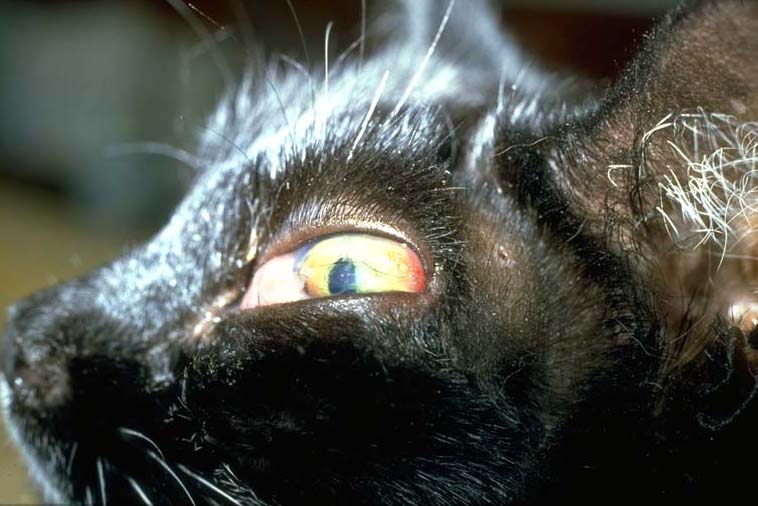Osteosarcoma
Introduction
- Signs: lameness, bony swelling.
- Diagnosis: radiography, histopathology.
- Treatment: surgical excision/amputation.
- Most common primary bone tumor in the cat (70-80% of primary malignant bone tumors).
Presenting signs
- Affects appendicular but also axial skeleton - the metaphyseal region of long bones but also ribs, pelvis, skull, vertebral column.
- Hindlimbs affected more than forelimbs (opposite to dogs).
Appendicular skeleton
- Lameness.
- Bony swelling.
- Pathological fracture.
Axial skeleton
- Enlarging bony mass.
- Exophthalmos
 .
. - Paraplegia.
- Difficulty breathing.
- Constipation Constipation.
Age predisposition
- Middle aged to old (9-12 years).
Pathogenesis
Pathophysiology
- Proliferation of neoplastic cells in bone with production of osteoid, bone or cartilage and destruction of normal bone.
- May cause pathological fracture.
- Metastasis is less common than in the dog.
- Proliferation of neoplastic osteoblasts in bone → production of osteoid, bone or cartilage matrix around cells and destruction of normal bone. Very painful and therefore weight-bearing reduced.
- Pathological fracture of long bones may occur as cortex and medulla is destroyed.
- Mass affecting ribs may impair breathing or → pleural effusion.
- Mass affecting pelvis may → constipation.
- Mass in vertebral column may → paraplegia.
- Dispersal of tumor cells into peripheral blood occurs late in the disease and is much less common than in the dog, hence metastasis is rare.
- Metastases (when occur) usually seen in lungs (kidney metastases also reported).
Timecourse
- Weeks to months.
- Slower for parosteal tumors.
Diagnosis
Subscribe To View
This article is available to subscribers.
Try a free trial today or contact us for more information.
Treatment
Subscribe To View
This article is available to subscribers.
Try a free trial today or contact us for more information.
Prevention
Subscribe To View
This article is available to subscribers.
Try a free trial today or contact us for more information.
Outcomes
Subscribe To View
This article is available to subscribers.
Try a free trial today or contact us for more information.
Further Reading
Publications
Refereed papers
- Recent references from PubMed and VetMedResource.
- Spugnini E P, Ruslander D & Bartolazzi A (2001) Extraskeletal osteosarcoma in a cat. JAVMA 219 (1), 60-62 PubMed.
- Heldmann E, Anderson M A & Wagner-Mann C (2000) Feline osteosarcoma 145 cases (1990-1995). JAAHA 36 (6), 518-521 PubMed.
- Bitetto W V, Patnaik A K, Schrader S C et al (1987) Osteosarcoma in cats - 22 cases (1974-1984). JAVMA 190 (1), 91-93 PubMed.
- Quigley P J & Leedale A H (1983) Tumours involving bone in the domestic cat - a review of fifty-eight cases. Vet Pathol 20 (6), 670-686 PubMed.
- Liu S K, Dorfam H D & Patnaik A K (1975) Primary and secondary bone tumours in the cat. JSAP 15 (3), 141-156 PubMed.